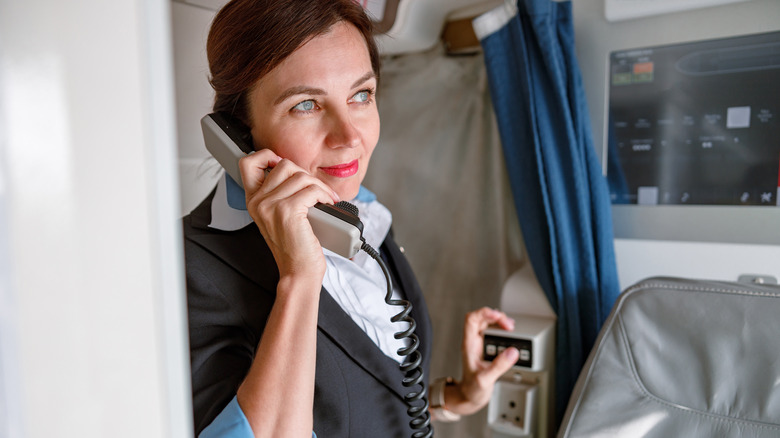Why Do Planes Have Phones For Flight Attendants? Here's How They're Used
Flying on a commercial airline means dealing with the TSA's rules regarding electronics, namely your cellphone, while onboard. But flight attendants have access to tethered phones throughout the journey for different reasons. These systems are part of how the crew stays connected and keeps everything on track, even when most of it goes unnoticed by those in the cabin.
Flight attendants use onboard phones to stay in constant contact with the cockpit, with other crew members throughout the cabin, and with the ground when needed. But it's not just for convenience — it's a key part of how the crew keeps the flight safe and coordinated. If there's an issue in the cabin, the interphone system gives them a direct line to the pilots without needing to leave their posts. The setup also lets attendants connect with other stations throughout the aircraft, so they can stay in sync during service or in case something goes wrong during the flight.
The same system that connects the crew also plugs into the aircraft's announcement setup. So when a pilot or flight attendant needs to make an announcement, their message automatically cuts through anything else playing, like movies, boarding music or pre-recorded messages. That's because the audio system is built with a clear priority structure: the flight deck comes first, followed by attendants, then automated content. It's a simple way to make sure passengers hear what matters, exactly when they need to.
Flight communication has evolved over the years
While the airplane phone systems flight attendants use rely mostly on wired setups, the industry is moving toward wireless as a smarter, more flexible alternative. New systems are being developed that cut down on weight, simplify installation, and give crew members more freedom to move while staying connected. As more airlines and manufacturers look to update their aircraft, wireless intercom technology is quickly becoming part of that conversation, offering a practical way to improve both safety and efficiency in the air.
But long before these crew-focused systems became the norm, passengers had their own way to make calls during a flight, thanks to a service called Airfone. Airfone let passengers place calls while onboard, using built-in handsets and a credit card. Unlike the interphone system, which is strictly for crew coordination and safety, Airfone was designed for personal calls, mainly to share updates with people on the ground. But while it sounds like a convenient system without today's hassle of dealing with "ariplane mode," the calls were expensive. Connections were shaky at best, because they depended on ground towers, which didn't always work well at cruising altitudes or over oceans.
The rise of cellphones and the internet decreased the need for Airfone over the years, and the system was eventually phased out. So as travelers found cheaper, easier ways to stay connected, communication inside the cabin has become more advanced — and more essential.

